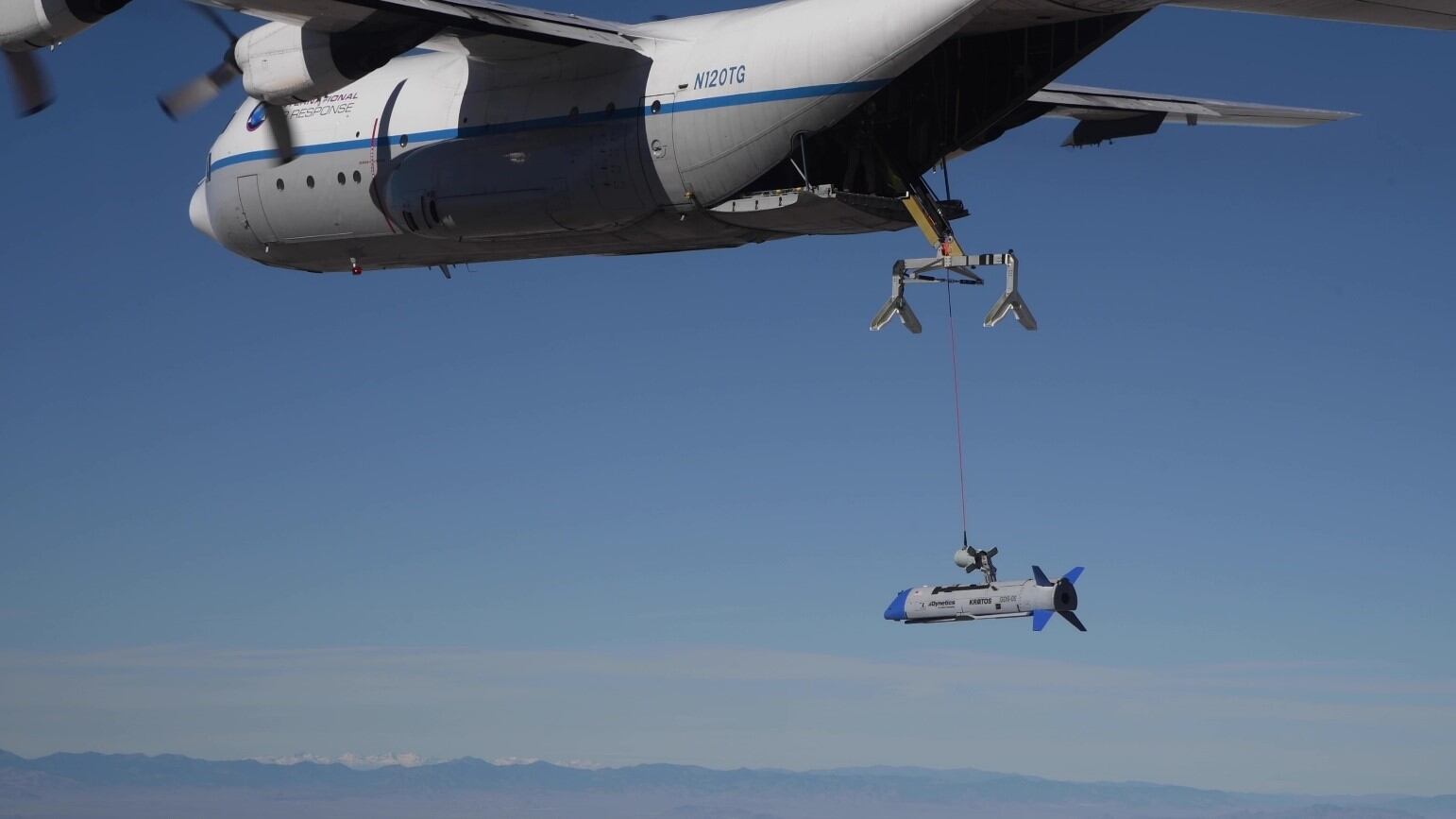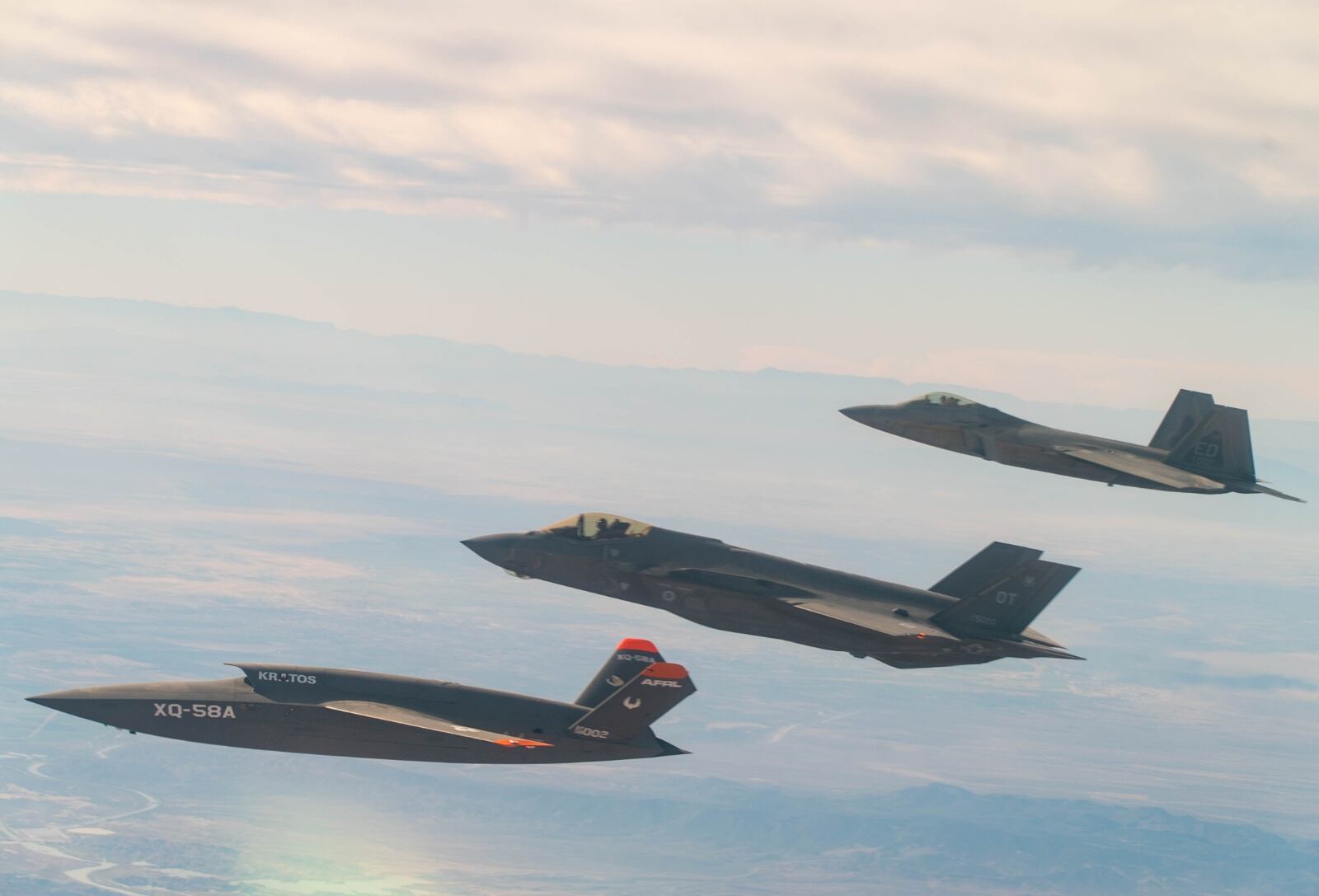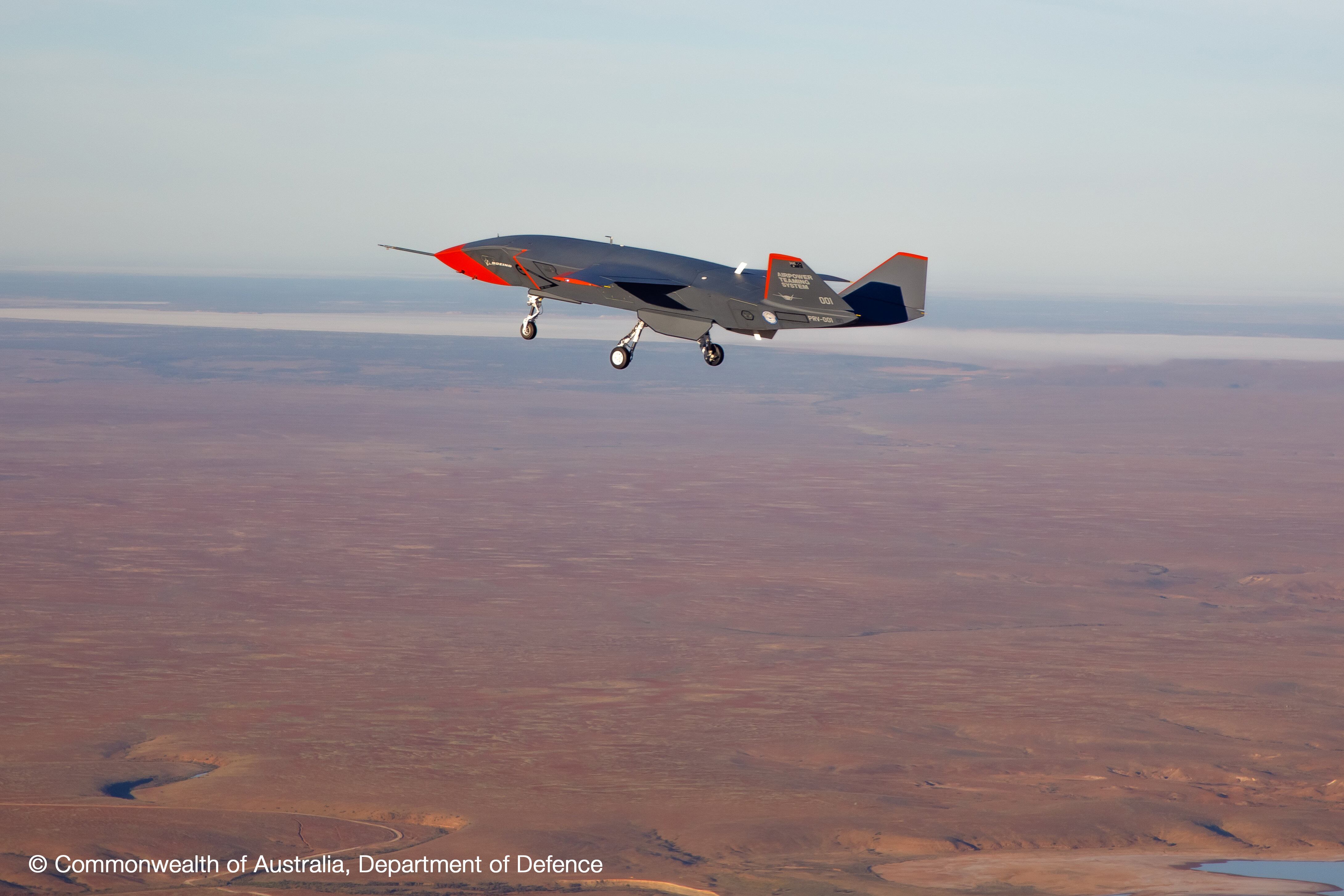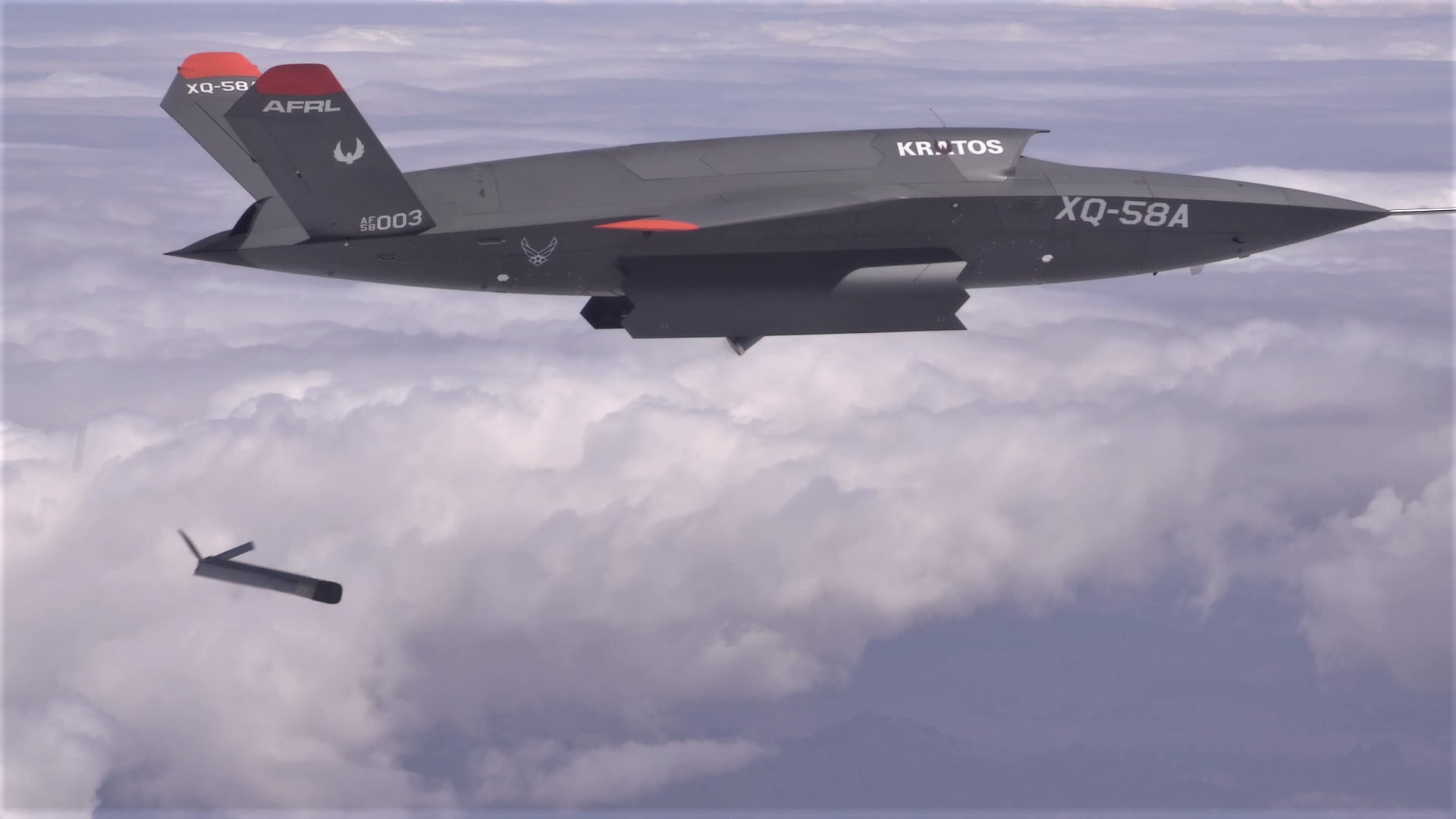WASHINGTON — Imagine that sometime in the next decade, a long-feared war with China has erupted. In a bid to destroy Chinese defenses and break through to its airspace, the U.S. Air Force sends its advanced fighter jets and bombers into the most hostile territory it’s faced in decades.
But this mission is different than those of the past. Swarming alongside each manned aircraft is a handful of small drone wingmen, operating with minimal direction from the accompanying pilot. They scout ahead to map out targets, use electronic warfare capabilities to jam enemy signals, and launch their own missiles to carry out airstrikes and destroy targets — multiplying the effect a single pilot can have in battle.
This is the future of warfare envisioned by top Air Force leaders — most notably, Air Force Secretary Frank Kendall. And he’s confident this isn’t just a sci-fi pipe dream.
“The technology is there now, where we can talk about a formation of a manned aircraft controlling multiple unmanned aircraft,” Kendall said during a Jan. 19 forum with the Center for a New American Security. “There’s enough technology in existence from programs that we’ve already conducted, it convinces me that’s not a crazy idea.”
For years, the Air Force has floated the possibility of teaming up drones and manned aircraft — most notably as a possible feature of its secretive Next Generation Air Dominance platform.
But now, the Air Force’s plans for doing so are coming into focus — and energizing defense firms who hope their years of work pairing manned and unmanned systems will pay off.
“We’re catching the wave that’s now being created,” said Richard Sullivan, an executive at Northrop Grumman, adding he’s been “very excited” by Kendall’s recent comments.
Aerial combat is headed toward this teaming approach, Lt. Gen. Clint Hinote, deputy chief of staff for strategy, integration and requirements, said on a November panel, though he cautioned the Air Force is still experimenting to work through the details.
“We don’t even know exactly how this is going to unfold yet,” Hinote said. “But it is clear that the autonomous collaborative platforms, we like to call them, or unmanned systems, are going to be a major part of the future of warfare.”
With the U.S. military shifting its focus to winning a war against an advanced adversary, such as China, experts say the manned-unmanned teaming concept would be crucial to the U.S. prevailing.
The Air Force Research Laboratory laid the groundwork for a future manned-unmanned teaming through its Skyborg program, an artificial intelligence-driven wingman that underwent its first flight test in a drone last April. More recently, the Defense Advanced Research Projects Agency made progress on its X-61A Gremlins program, which seeks to deploy and then recover swarms of small, sensor-laden drones from cargo planes in flight. Last October, the agency flew and successfully recovered in midair a small Gremlin drone for the first time.
The Royal Australian Air Force has also made strides the way with its Loyal Wingman program, also known as the Airpower Teaming System. The armed service in March 2021 announced a $115 million contract with Boeing for three more autonomous Loyal Wingman drones, which would bring the force’s total to six aircraft that it hopes to one day fly alongside manned fighters.
A ‘natural evolution’
Hawk Carlisle, a retired general who formerly led Air Combat Command, said the ability to extend an aircraft’s reach with AI-infused wingmen is the next step for air combat.
“This is a natural evolution, especially when you look at the capability today with respect to AI, with respect to systems, with respect to the computing power and capability you can put in a particular size” aircraft, noted Carlisle, who is now the chief executive of the National Defense Industrial Association.

For the last 20 years, the Air Force has flown drones like the MQ-9 Reaper in the largely permissive environments of the Middle East and Afghanistan, conducting airstrikes and feeding the military’s insatiable need for intelligence, surveillance and reconnaissance.
But the next war will need much more. In a conflict with a peer like China, Carlisle said, the environment would be greatly contested, requiring additional capacity alongside fighter aircraft and meaning additional dilemmas and confusion.
These drone wingmen could fill a number of roles, experts say. They could broaden the “mother” aircraft’s situational awareness by flying ahead with infrared, electromagnetic, radar or visual sensors. This could improve the human pilot’s situational awareness, map out targets, or identify the location of radars and air defense systems to provide a clear corridor for the manned aircraft.
They could also serve as communications nodes for friendly forces, or conduct electronic warfare operations by jamming enemy radars, communications or other signals. If they are large enough to carry their own armaments, they could carry out their own air-to-air or air-to-ground strikes alongside the manned aircraft, giving the enemy multiple threats to counter.
But even without onboard weapons, a drone swarm could serve as a decoy to befuddle the enemy, sending out false signals that make it difficult for the adversary to differentiate between the manned and unmanned aircraft.
Former F-16 pilot Heather Penney, now a senior resident fellow at the Mitchell Institute for Aerospace Studies, told Defense News that having autonomous drone wingmen taking on side tasks will allow pilots to concentrate on the bigger picture.
“It’ll … free humans to do more of what human cognition is really adept at — these really complex kinds of intuitive tasks,” Penney said.
But the Air Force must also ensure the pilot isn’t overloaded while trying to conduct that orchestra, she added. It’s unclear how the pilot would control these wingmen.

The Air Force declined to comment for this story, but top officials have recently offered details on what they envision.
In a Dec. 9 forum with Defense One, Kendall said one of his top priorities is identifying how to get combat drones ready to fly in real-world operations alongside manned aircraft. This could entail as many as five unmanned aircraft controlled by a single fighter.
The Air Force primarily envisions this as part of the NGAD concept, Kendall said, but it could be adapted to operational F-22 and F-35 jets.
“The idea is the manned aircraft is essentially calling plays, and he’s using these other unmanned combat aircraft basically as a formation, to do things that make sense tactically,” Kendall said. “This opens up a whole bunch of opportunities.”
Kendall also floated the possibility of extending this concept to the B-21 Raider, which is under development, and networking such unmanned aircraft together under the bomber’s control in a loose formation against the enemy.
But the finer points are still to be determined, he acknowledged, including the mix of aircraft, drone payloads and what “plays” would be preprogrammed into the unmanned systems.
Business opportunities
The growth in the autonomous teaming market also gives firms like Kratos and General Atomics — companies smaller than the defense giants of Lockheed Martin and Boeing — an opening to grow their business with the Defense Department, Penney said.
Both Kratos and General Atomics have landed contracts with the Air Force to keep working on their XQ-58A Valkyrie and MQ-20 Avenger programs, respectively, as autonomous drone wingmen for the Skyborg program. “They could then become major players and establish themselves as … really becoming strong defense industry partners for the Department of Defense with autonomous teaming,” Penney said.
Steve Fendley, president of Kratos’ Unmanned Systems Division, told Defense News that the firm is watching Kendall’s increasingly focused statements on the subject with great interest.
“We bring systems that are already flying … have already proven a number of different critical capability aspects … [and] that are affordable,” Fendley said. “We’re fully committed to the opportunity associated with this defense application. We’re evolving with the DoD requirements as the DoD requirements evolve.”

Steve Nordlund, Boeing’s interim vice president and general manager for autonomous systems, said in an emailed statement the company welcomes the Air Force’s growing emphasis on autonomous capabilities. As examples of products Boeing can offer, he pointed to the company’s work testing autonomous capabilities in the MQ-25, Airpower Teaming System, Extra Large Unmanned Undersea Vehicle and operational autonomous craft such as the X-37B Orbital Test Vehicle.
“We are entering a new era in which rapidly evolving technology is determining how wars are fought and won, and autonomous technologies can extend and connect human capabilities across all domains,” Nordlund said.
But for this concept to work, Kendall said in January, these drones will have to be cheap — or at least cheaper than the manned aircraft. Cost savings are one of the factors driving the Air Force in this direction, he said, because if the service only buys expensive manned aircraft, it will be unable to afford the force it needs to win wars. Alternatively, low-cost drones would allow it to expand its capability while staying within budget.
Kendall also said those drones must be at least attritable — meaning reusable, but inexpensive enough that the Air Force could afford to lose them in combat — if not completely expendable. This would allow the Air Force to attempt riskier missions it wouldn’t otherwise consider for fear of sending a pilot on, essentially, a suicide mission.
Other questions about the drones remain, Carlisle said: How would they be deployed and recovered in a combat environment? Would they be recovered aboard the aircraft they’re paired with? Would they land on their own or parachute into water? How will they be recovered?
Deployment methods are another question. Carlisle said these drones don’t necessarily have to be carried into combat by the aircraft with which they’re paired. Instead, he explained, they could be launched from the bay of large cargo aircraft, similar to the palletized munition concept the Air Force Research Laboratory is testing.
A B-21′s bomb bay may have the capacity to carry these drones, he added, but a fighter would likely have to preserve its limited pylon space for munitions.
And building a culture in the Air Force where everybody understands the capabilities of these systems — and trusts them — will take time, Penney said.
“It’s not going to be sufficient in a highly contested environment to just strap an iPad onto your leg and go from there,” Penney said. “We’re going to need to provide these flight leads and mission commanders fully integrated and elegant interfaces to be able to supervise, direct and control — not like stick and rudder control, but command — their autonomous teaming aircraft.”
Hinote said that in combat, the potential always exists for enemies to “fracture” the U.S. military’s capability to communicate, which is why these unmanned systems will need “tiers of autonomy” that allow them to carry out their assigned missions — within limits — if that happens.
For example, he said, the military wouldn’t want an autonomous system going forward with actions a human might want to veto, and there should be restrictions on timing, geographic reach and missions it would autonomously carry out.
Former Air Force Secretary Deborah Lee James said the service’s work on the Joint All-Domain Command and Control architecture will be vital for networking with these unmanned systems and ensuring they remain in sync and under control.
Likewise, if an autonomous system starts “misbehaving,” Penney said, the Air Force needs a protocol to tell it to go home, land and not automatically download its data. The system would need to be quarantined until experts figure out what went wrong and how to fix it, she added.
But the ethical questions of conducting warfare — and potentially killing people — with autonomous devices must be considered, James said.
AI systems would be designed to independently learn and act, such as taking evasive actions if a threat emerges, James said. But she doubts the military would empower an autonomous system to make its own decisions on whether to shift from one target to another, if that newly acquired target potentially involved human casualties.
Penney also underlined the importance of having human supervision over these drones, even when they’re operating autonomously.
“This does not mean that these autonomous teammates will be ‘killer bots’ without any kind of human control or supervision,” Penney said. “A lot of people think that we’re moving into this world of sky bots, killer robots, and really taking our morals, our ethics, our values out of the system and reducing it to a mathematical algorithm. That’s simply just not the case.”
Stephen Losey is the air warfare reporter for Defense News. He previously covered leadership and personnel issues at Air Force Times, and the Pentagon, special operations and air warfare at Military.com. He has traveled to the Middle East to cover U.S. Air Force operations.





